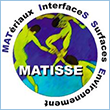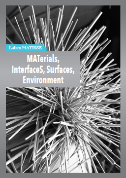Adsorption of Benzotriazoles on Cu(111) Surface and its Corrosion Inhibition CapacityPr. Juan Carlos Santos - Friday, September 16th, 2016 at 11:00 a.m - Campus Jussieu, room 101, 1st floor [32-42]

In the context of corrosion/passivation on power transformers, the adsorption of benzotriazole (BTAH) and some derivatives (5-Methyl, 5-Amine, 1-Amine, 1-Methyl) on a Cu(111) surface model has been investigated using periodic density functional (DFT) calculations and the results have been contrasted with experimental assays. The adsorption of neutral (BTAH) and radical (BTA●) forms and the solvent effect were considered.
The Cu-N interaction provides a stable complex with adsorption over top sites. Neutral and radical forms have very different adsorption energies, the latter, yielding the most stable one.
The charge transfer between adsorbate and adsorbent was used to describe the electronic structure of the adsorption complexes. According to Bader population analysis, it was found that a charge transfer occurs from the surface Cu(111) to benzotriazols , whereas in the processes with BTAH or neutral forms, a lower, almost null, rate of charge transfer is calculated. In case of the studied derivatives, it was found that a methyl group located in position 5 increases the interaction whereas an amine group located in the same position decreases it.
The role of benzotriazoles as passivators are described and compared with the adsorption of dibenzyldisulfide, DBDS, a strong corrosive compound. Although, in both cases the electron transfer occurs from surface to the adsorbate, it produces different results. The corrosive agent produces a disulfide bond dissociation lowering the adsorption energy. In contrast, with passivators, the charge transfer is exclusively responsible for the adsorbate-surface interaction yielding stronger adsorption than when the corrosive agent is adsorbed.
References :
- J. C. Santos, C.A. Escobar, F. Ocayo, F. Tielens, M. Saavedra-Torres, 1,2,3-Benzotriazole Derivates Adsorption on Cu(111) Surface: A DFT Study, To be submitted soon!
- M. Saavedra-Torres, F. Tielens, J. C. Santos, Dibenzyl Disulfide Adsorption on Cu(111) Surface; A DFT Study, Theoretical Chemistry Accounts, 135, 7 (2016).
- M. Saavedra-Torres, P. Jaque, F. Tielens, J. C. Santos, Theoretical Study of Dibenzyl Disulfide Adsorption on Cu7 Cluster as a First Approximation to Sulfur-Induced Copper Corrosion Process, Theoretical Chemistry Accounts, 134, 73 (2015).
Egalement dans la rubrique
MATISSE en chiffres
- 4 disciplines : Chimie, Physique, Sciences de la Terre, Patrimoine
- 400 permanents
Contact
Direction
Florence Babonneau
Administration
Communication
Emmanuel Sautjeau



